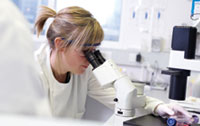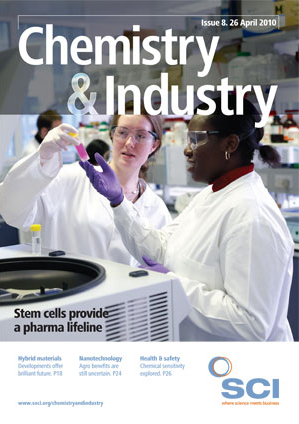Stem cell technologies that promise to cure, rather than treat, disease could offer struggling pharma companies a new lease of life, reports Susan Aldridge
This summer is likely to see two milestones in regenerative medicine. Europe’s first public stem cell company, ReNeuron in Guildford, UK, is set to begin a Phase I clinical trial of its expanded neural stem cells for stroke disability. Twelve patients at Glasgow’s Southern General Hospital will receive the cells and will be monitored for safety and even potential efficacy. Meanwhile, Geron, in Menlo Park, California, US, plans a Phase I study of its human embryonic stem cell (hESC)-derived oligodendrocyte progenitor cells in acute spinal cord injury.
Stem cell therapies
Multiple sclerosis (MS) is another neurological indication where stem cell therapies are moving to the clinic. The Multiple Sclerosis Society has teamed up with the UK Stem Cell Foundation in an initiative that makes up to £1m of seed funding available from September 2010 to progress promising therapies into Phase I/II. So, the signs are that regenerative medicine is gathering momentum. Companies, and academic groups, around the world have promising preclinical work, therapies in trial – around 40 in bone marrow derived stem cells alone – and, even, a few products on the market in areas like diabetes, neurology, blindness, heart attack, stroke, bone and joint repair and inflammatory disease. These therapies offer patients radical new options in chronic disease and unmet medical needs. ‘Regenerative medicine is potentially a one-off cure, rather than a therapy,’ explains Richard Archer, who heads the BioIndustry Association’s RegenMed interest group, which is helping to foster the regenerative medicine industry.
Regenerative medicine includes therapies consisting of cells, biocompatible materials, or a combination of the two, or small molecules that can stimulate tissue repair. The aim is to replace, or regenerate, cells, tissues or organs to restore, or establish, normal function. Most cell-based therapies use some kind of stem cell – derived from various sources such as embryonic or fetal tissue, bone marrow or even fatty tissue.
There has been excitement over induced pluripotent stem (iPS) cells, which are stem cells derived from reprogrammed adult cells, such as skin cells, as these could potentially replace controversial embryonic sources. But iPS technology is still in its early days and it will be some while, if ever, before they can be used in treatments.
‘Stem cells have three broad applications for pharma,’ explains Chris Mason, who heads the Regenerative Medicine Bioprocessing Unit at University College London: ‘They can be utilised as tools to discover and develop new medicines, they can be used as targets to help big pharma find new drugs, which can trigger the body’s own stem cells, and they can also be deployed as therapies.’
Recent research has shown that cell therapies are more than a straightforward replacement for dead or damaged tissue. ‘Stem cells have two functions,’ Mason adds. ‘They can be used to rebuild tissue but also, if adult stem cells are put into acute diseases with an immunological component, the progress of the disease can be modulated and major damage prevented.’
Stem cells produce many different molecules, which can modify the tissue environment where damage has occurred – such as in MS or after a heart attack or stroke. The challenge is understanding what a particular stem cell is producing and the molecular pathways it is capable of modifying. In such cases, the stem cells are providing a transient type of therapy, rather than a permanent replacement.
Madrid-based Cellerix, for example, is using stem cells to repair fistula, a painful condition that often occurs as a complication of Crohn’s disease. The Spanish company’s product Ontaril is intriguing because it is derived from adipose (fat) tissue, obtained from patient liposuction. Adipose stem cells (ASCs) are isolated, expanded in the lab, then injected back into the patient. ‘The most common source of stem cells has been bone marrow, but we believe adipose tissue is an even better source, because it is easier to access,’ said Cellerix ceo Eduardo Bravo. ‘There are also between 100 and 1000 times more stem cells in adipose tissue than in bone marrow.’ Ontaril is now in Phase III - the world’s first-ever clinical trials of ASCs.
Meanwhile, US biotech Athersys is developing its bone marrow-derived MultiStem technology for applications including myocardial infarction, graft versus host disease, stroke and various disorders involving the immune system, like inflammatory bowel disease. ‘The cells home in on the injured site and then work through multiple pathways including angiogenesis, immunomodulation and reduction of inflammation,’ explains Bob Deans, Athersys’ VP regenerative medicine. ‘We are now building an increasingly strong picture of how the cells work.’
MultiStem is an ‘off the shelf’ product, where donor stem cells are expanded to create a bank containing millions of doses, all characterised for consistency and safety. Athersys is carrying out a Phase I trial, where the cells are administered into the heart muscle of patients after heart attack. Deans believes that big pharma has been hesitant about getting involved in stem cells because of lack of clarity on mode of action. But Athersys’ efforts in this respect have paid off, in the form of a deal with Pfizer, which will fund development and commercialisation of MultiStem for inflammatory bowel disease.
Public commitment to cell therapies

Pfizer has also set up deals with San Diego-based Novocell and with UCL’s Institute for Ophthalmology. Novocell is developing a hESC-based therapy for diabetes, hoping to supply pancreatic cells that make insulin. The UCL deal is focused on differentiation of hESCs into retinal pigment epithelial cells for treating of age-related macular degeneration. At the same UCL institute, Julie Daniels’ team has already hit the headlines with pioneering work in limbal corneal cell transplantation. The procedure has a high success rate in restoring sight to patients whose corneas have become scarred through chemical accidents. Hundreds of these operations have now been carried out in the UK, Italy and India.
Helping patients with injuries through stem cell therapy is also the mission of Belgian firm TiGenix – Europe’s largest regenerative medicine company. TiGenix’ ChondroCelect is a cell-based product for traumatic injuries caused by accidents or sport and the first to gain approval through the new EU Advanced Therapy Medicinal Products (ATMP) Regulations. Scientists culture cells, taken from a small cartilage biopsy from the patient, under Good Manufacturing Practice (GMP) conditions. ‘We have optimised the whole cell culture system,’ says ceo and co-founder Gil Beyen. He stresses how important it is to identify the right cells for culture. Accordingly, TiGenix did a lot of gene profiling to look for the right markers and the right cells. Clinical trials show that ChondroCelect gives a superior, long term, structural repair of the lesion, compared with the usual surgical intervention.
The product is now at the pre-launch stage in The Netherlands, Germany and the UK. TiGenix recently purchased the UK biomaterials company Orthomimetics to develop chondromimetic products without cells to heal smaller lesions.
Meanwhile, stem cells are playing an increasingly important role in drug discovery. The Harvard Stem Cell Institute’s Therapeutic Screening Center and iPS core facility is helping big pharma with this, according to executive director Brock Reeve. ‘The reprogramming technology is very important, because it could lead to the development of new in vitro disease models,’ Reeve says. He believes that earlier toxicity testing, on better models, will help pharma avoid costly failures in Phase III. It’s a message that has been heard by GlaxoSmithKline, which has set up a five-year $25m collaboration with HCSI in cardiovascular, cancer and obesity to find better, safer medicines.
But there are many challenges involved in bringing regenerative medicine to the patient. ‘Technically, cell therapies are inherently more complex than conventional pharmaceuticals,’ Archer says. ‘They are very different from a small molecule pharmaceutical or even a biologic. The manufacturer has to be good at more things. Cost of goods is also a significant part of the sales price for a cell therapy, while it could be less than one percent for a tablet. So you need a very effective manufacturing project from the outset.’
In the UK, Archer is working with David Williams at Loughborough University, along with the Universities of Nottingham and Keele, where the EPSRC has invested £5.3m in its Centre for Innovative Manufacturing in Regenerative Medicine. The team is looking at issues such as GMP manufacturing, control processes, and Quality by Design, as well as hospitalbased delivery platforms. The investment underlines the importance of such high tech manufacturing for the UK’s economic future.
One company that has tackled many of these technical problems, including scalability, is Lonza, the largest contract manufacturing organisation (CMO) for cell-based therapies. At its dedicated facility in Walkersville, Maryland, US, Lonza now produces 100bn cells/batch, which allows for 50- 100m cells/dose. Having to work with ‘adherent’ cells grown on a surface rather than in suspension has been a particular challenge because of the issues around what surface to use and how to attach and detach them, says facility manager David Smith. Another issue is making sure cost of goods is low enough to be able to offer treatment to those who need it. ‘It would be terrible if we had to ration treatment,’ Smith says.
Regulation is the other major challenge. Geron’s application for its hESC therapy was the largest investigational new drug (IND) application the US Food and Drug Administration (FDA) had ever had, and Phase I is currently on clinical hold while the firm conducts further studies. ReNeuron also had a long and winding path to approval, turning to the UK after a series of setbacks and delays at the FDA. One issue for regulators is where stem cells go once they are in the body, and what are they doing. Reeve believes in vivo imaging and tracking systems for cells will be very important in answering these questions. ‘Regulation can become the rate determining step on speed to the clinic,’ Archer observes. ‘There is so much uncharted territory and no-one has been here before.’
There are also financial hurdles. ‘There is a translational funding gap between small animal work and successful Phase II. The venture capitalists are not in there,’ says Mason. ‘We desperately require joined up funding. We need the government to put its hands deep in its pockets, which is beginning to happen with the [UK] Technology Strategy Board’s major £21.5m R&D investment programme in regenerative medicine.’
‘Regenerative medicine is not easy, but the outcomes could be staggering,’ says Archer. ‘In five years, there should be five to ten therapies generally available and this will be a significant transformation in healthcare provision.’
Susan Aldridge is a freelance medical writer based in London.





